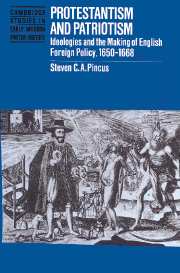Book contents
- Frontmatter
- Contents
- Acknowledgments
- List of abbreviations
- 1 Introduction
- Part I The rod of the Lord: ideology and the outbreak of the First Anglo-Dutch War
- Part II To unite against the common enemy: the 1654 Treaty of Westminster and the end of apocalyptic foreign policy
- Part III Popery, trade, and universal monarchy: ideology and the outbreak of the Second Anglo-Dutch War
- 11 Historiographical overview
- 12 The establishment of an Orangist foreign policy
- 13 The Anglo-Dutch treaty of 1662
- 14 The Northern Rebellion and the reestablishment of Anglican Royalist consensus
- 15 The April 1664 trade resolution
- 16 Popery, trade, and universal monarchy
- Part IV The Medway, Breda, and the Triple Alliance: the collapse of Anglican Royalist Foreign Policy
- Conclusion
- Bibliography
- Index
- Titles in the series
11 - Historiographical overview
Published online by Cambridge University Press: 01 October 2009
- Frontmatter
- Contents
- Acknowledgments
- List of abbreviations
- 1 Introduction
- Part I The rod of the Lord: ideology and the outbreak of the First Anglo-Dutch War
- Part II To unite against the common enemy: the 1654 Treaty of Westminster and the end of apocalyptic foreign policy
- Part III Popery, trade, and universal monarchy: ideology and the outbreak of the Second Anglo-Dutch War
- 11 Historiographical overview
- 12 The establishment of an Orangist foreign policy
- 13 The Anglo-Dutch treaty of 1662
- 14 The Northern Rebellion and the reestablishment of Anglican Royalist consensus
- 15 The April 1664 trade resolution
- 16 Popery, trade, and universal monarchy
- Part IV The Medway, Breda, and the Triple Alliance: the collapse of Anglican Royalist Foreign Policy
- Conclusion
- Bibliography
- Index
- Titles in the series
Summary
In May 1660, after almost a decade in the political wilderness, Charles II entered the United Provinces, the last stop on his triumphal return to the British Isles. The treatment which the States General and the States of Holland afforded their royal guest “was incredibly splendid and noble,” recalled the Earl of Clarendon, “and the universal joy so visible and real, that it could only be exceeded by that of [the king's] own subjects.” Samuel Pepys, who had come with his fellow former Cromwellian the Earl of Sandwich to The Hague to bring Charles II back to England, could not “speak enough of the gallantry of the town.” Charles II himself declared “his meaning of keeping a true and firm friendship and alliance with [the Dutch], nay that he should be jealous if any other king or prince should have a more near and stricter friendship and alliance with them than himself.” On 23 May after almost interminable festivities Charles finally boarded his ships at Scheveling. The shore, wrote one observer, was “covered black with people … come from several towns far and near to see the king's departure and were forced for want of lodgings to walk all night or lie in the open fields.” The salutes and countersalutes from the English and Dutch ships were so tremendous that “the air was set on fire and the smoke like a cloud had made the fleet invisible.”
- Type
- Chapter
- Information
- Protestantism and PatriotismIdeologies and the Making of English Foreign Policy, 1650–1668, pp. 195 - 198Publisher: Cambridge University PressPrint publication year: 1996



